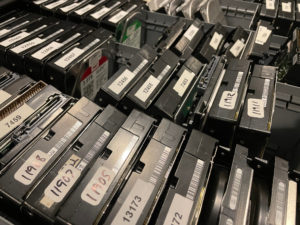
A drawer full of donor hard drives in Datarecovery.com’s parts inventory.
A new USB device is attracting attention for offering a “military-grade” solution to a common problem: How to permanently erase sensitive data from a hard drive.
The device appears to be the sole offering of the brand DESTRUCT, which claims it utilizes advanced algorithms and multi-pass techniques to thoroughly overwrite disk contents.
But for most users, this dedicated hardware may be unnecessary. We haven’t worked with a DESTRUCT USB gadget, but we’ve seen similar tools — and for the most part, they’re overkill. Here’s why.
USB Data Sanitization Gadgets: Not a Scam, But Nothing Special
The Destruct gadget plugs into a computer’s USB port and, as Yahoo! Tech reports, operates as a bootable environment to execute data sanitization software automatically.
Operating outside the computer’s primary operating system is key because it allows the device to overwrite the entire drive, including the OS, boot sectors, and hidden partitions. The goal is to ensure all data is destroyed by running comprehensive multi-pass programs.
The issue? You can download free software that performs the same function. If you’ve got a spare USB drive, for example, you might grab Darius Boot and Nuke (DBAN), a totally free utility that provides multiple options for data sanitization.
What Is “Military-Grade” Data Sanitization?
The term “military-grade” refers to highly specific, multi-pass overwriting standards, most famously the U.S. Department of Defense’s DoD 5220.22-M standard. We’re assuming that the Destruct gadget uses those methods, since buyers on Amazon have noted that the device can take multiple days to sanitize a single HDD.
These multi-pass methods were developed for older, low-density magnetic media where residual magnetic traces might theoretically be detected after a single overwrite.
“Theoretically” is an important bit of language: We’ve seen residual magnetic traces of data on extremely old media (such as floppy disks), but they weren’t nearly sufficient for data recovery purposes.
Given the high density of modern hard drives, magnetic artifacts are not a serious concern for data recovery (or data sanitization).
To Sanitize Data, a Single-Pass Overwrite is Sufficient
Today, for modern, high-density hard disk drives (HDDs), a single-pass overwrite with zeros or a random pattern is generally considered sufficient. The original data is made unrecoverable by any known software or laboratory technique.
Military-grade methods are valid but extremely time-consuming. Learn more about secure data wiping for HDDs in our article, How to Securely Wipe a Hard Drive Before Selling or Recycling It.
For SSDs, A Basic Format Sanitizes the Drive
If you are dealing with a Solid State Drive (SSD), the process is different, and a utility like DBAN isn’t necessary — fully overwriting the memory cells of an SSD will put unnecessary wear on the device. Most data sanitization programs will refuse to execute multiple overwrites on an SSD for that reason.
For a modern SSD, a full format is fine. The drive’s internal firmware uses TRIM to ensure deleted blocks are quickly and completely emptied. The most reliable method is to use the drive’s built-in ATA Secure Erase command, which instantly resets all storage cells. Most SSD manufacturers provide a free utility (e.g., Samsung Magician, Crucial Storage Executive) to execute this command easily.
Understanding the NIST SP 800-88 Guidelines
For commercial, government, or regulated environments, security protocols must be precise and verifiable. The National Institute of Standards and Technology (NIST) created Special Publication 800-88: Guidelines for Media Sanitization, which defines three distinct security levels for data destruction:
- Clear: A software overwrite (like DBAN). It protects against simple, non-invasive data recovery techniques. This is effective for HDDs but is considered a minimum level of security.
- Purge: Protects against state-of-the-art laboratory attacks. For HDDs, this involves degaussing (destroying the magnetic field) or a certified multiple-pass overwrite. For SSDs, it usually involves cryptographically erasing the encryption key.
- Destroy: The most secure method, rendering the media permanently unusable. It involves physical destruction methods like incineration, pulverizing, or shredding.
These defined standards ensure that organizations select the correct sanitization method to meet their specific risk profile, regulatory obligations (like HIPAA), and the type of storage media they are using.
When Professional Data Sanitization Is Required
For individuals, a quick USB gadget or a free utility is sufficient. However, when decommissioning assets for a business, a healthcare provider, or a government organization, security and legal compliance are the top priority.
Protecting your organization from a data breach requires an auditable, verified, and legally defensible process. This is where professional, at-scale data sanitization services become necessary.
At Datarecovery.com, we utilize specialized hardware and processes, such as magnetic degaussing and certified software solutions that meet or exceed the NIST standard. Crucially, we maintain a complete chain of custody — documentation that is essential for passing an audit or meeting regulatory requirements.
If your organization has decommissioned data storage media and requires a verified, certified, and compliant destruction process, we offer secure solutions.
Call 1-800-237-4200 to discuss your media destruction project with an expert or submit a case online.





